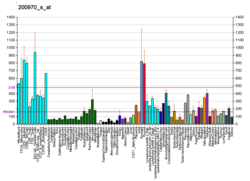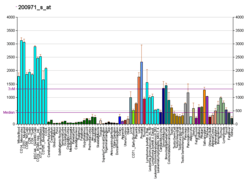SERP1
Stress-associated endoplasmic reticulum protein 1 is a protein that in humans is encoded by the SERP1 gene.[5][6][7]
References
- 1 2 3 GRCh38: Ensembl release 89: ENSG00000120742 - Ensembl, May 2017
- 1 2 3 GRCm38: Ensembl release 89: ENSMUSG00000027808 - Ensembl, May 2017
- ↑ "Human PubMed Reference:".
- ↑ "Mouse PubMed Reference:".
- ↑ Yamaguchi A, Hori O, Stern DM, Hartmann E, Ogawa S, Tohyama M (Jan 2000). "Stress-associated endoplasmic reticulum protein 1 (SERP1)/Ribosome-associated membrane protein 4 (RAMP4) stabilizes membrane proteins during stress and facilitates subsequent glycosylation". J Cell Biol. 147 (6): 1195–204. PMC 2168098
 . PMID 10601334. doi:10.1083/jcb.147.6.1195.
. PMID 10601334. doi:10.1083/jcb.147.6.1195. - ↑ Wiemann S, Weil B, Wellenreuther R, Gassenhuber J, Glassl S, Ansorge W, Bocher M, Blocker H, Bauersachs S, Blum H, Lauber J, Dusterhoft A, Beyer A, Kohrer K, Strack N, Mewes HW, Ottenwalder B, Obermaier B, Tampe J, Heubner D, Wambutt R, Korn B, Klein M, Poustka A (Mar 2001). "Toward a catalog of human genes and proteins: sequencing and analysis of 500 novel complete protein coding human cDNAs". Genome Res. 11 (3): 422–35. PMC 311072
 . PMID 11230166. doi:10.1101/gr.GR1547R.
. PMID 11230166. doi:10.1101/gr.GR1547R. - ↑ "Entrez Gene: SERP1 stress-associated endoplasmic reticulum protein 1".
Further reading
- Hu RM, Han ZG, Song HD, et al. (2000). "Gene expression profiling in the human hypothalamus-pituitary-adrenal axis and full-length cDNA cloning.". Proc. Natl. Acad. Sci. U.S.A. 97 (17): 9543–8. PMC 16901
 . PMID 10931946. doi:10.1073/pnas.160270997.
. PMID 10931946. doi:10.1073/pnas.160270997. - Hartley JL, Temple GF, Brasch MA (2001). "DNA cloning using in vitro site-specific recombination.". Genome Res. 10 (11): 1788–95. PMC 310948
 . PMID 11076863. doi:10.1101/gr.143000.
. PMID 11076863. doi:10.1101/gr.143000. - Strausberg RL, Feingold EA, Grouse LH, et al. (2003). "Generation and initial analysis of more than 15,000 full-length human and mouse cDNA sequences.". Proc. Natl. Acad. Sci. U.S.A. 99 (26): 16899–903. PMC 139241
 . PMID 12477932. doi:10.1073/pnas.242603899.
. PMID 12477932. doi:10.1073/pnas.242603899. - Ota T, Suzuki Y, Nishikawa T, et al. (2004). "Complete sequencing and characterization of 21,243 full-length human cDNAs.". Nat. Genet. 36 (1): 40–5. PMID 14702039. doi:10.1038/ng1285.
- Gerhard DS, Wagner L, Feingold EA, et al. (2004). "The status, quality, and expansion of the NIH full-length cDNA project: the Mammalian Gene Collection (MGC).". Genome Res. 14 (10B): 2121–7. PMC 528928
 . PMID 15489334. doi:10.1101/gr.2596504.
. PMID 15489334. doi:10.1101/gr.2596504. - Wiemann S, Arlt D, Huber W, et al. (2004). "From ORFeome to biology: a functional genomics pipeline.". Genome Res. 14 (10B): 2136–44. PMC 528930
 . PMID 15489336. doi:10.1101/gr.2576704.
. PMID 15489336. doi:10.1101/gr.2576704. - Kimura K, Wakamatsu A, Suzuki Y, et al. (2006). "Diversification of transcriptional modulation: large-scale identification and characterization of putative alternative promoters of human genes.". Genome Res. 16 (1): 55–65. PMC 1356129
 . PMID 16344560. doi:10.1101/gr.4039406.
. PMID 16344560. doi:10.1101/gr.4039406. - Mehrle A, Rosenfelder H, Schupp I, et al. (2006). "The LIFEdb database in 2006.". Nucleic Acids Res. 34 (Database issue): D415–8. PMC 1347501
 . PMID 16381901. doi:10.1093/nar/gkj139.
. PMID 16381901. doi:10.1093/nar/gkj139.
This article is issued from
Wikipedia.
The text is licensed under Creative Commons - Attribution - Sharealike.
Additional terms may apply for the media files.






